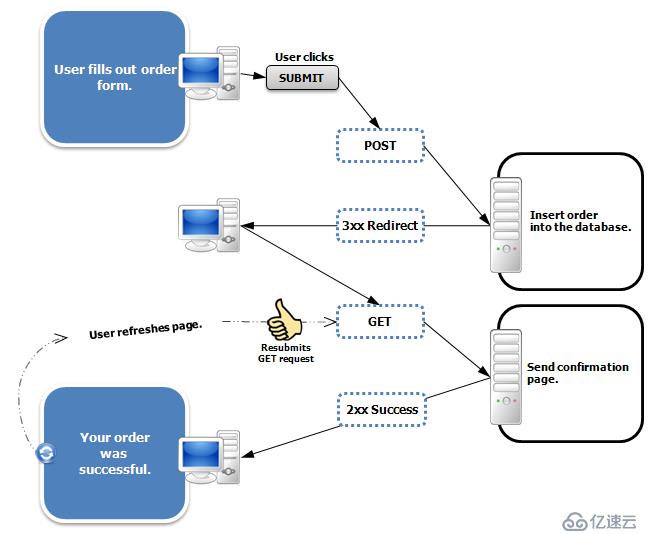Spring MVC 3.1版本加了一个很有用的特性,Flash属性,它能解决一个长久以来缺少解决的问题,一个POST/Redirect/GET模式问题。
正常的MVC Web应用程序在每次提交都会POST数据到服务器。一个正常的Controller (被注解 @Controller标记)从请求获取数据和处理它 (保存或更新数据库)。一旦操作成功,用户就会被带到(forward)一个操作成功的页面。传统上来说,这样的POST/Forward/GET模式,有时候会导致多次提交问题. 例如用户按F5刷新页面,这时同样的数据会再提交一次。
为了解决这问题, POST/Redirect/GET 模式被用在MVC应用程序上. 一旦用户表单被提交成功, 我们重定向(Redirect)请求到另一个成功页面。这样能够令浏览器创建新的GET请求和加载新页面。这样用户按下F5,是直接GET请求而不是再提交一次表单。

Image credit: Wikipedia

Idiot_s_Sky
翻译于 3年前
5人顶
翻译得不错哦!
虽然这一方法看起来很完美,并且解决了表单多次提交的问题,但是它又引入了一个获取请求参数和属性的难题. 通常当我们生成一次http重定向请求的时候,被存储到请求数据会丢失,使得下一次GET请求不可能访问到这次请求中的一些有用的信息.
Flash attributes 的到来就是为了处理这一情况. Flash attributes 为一个请求存储意图为另外一个请求所使用的属性提供了一条途径. Flash attributes 在对请求的重定向生效之前被临时存储(通常是在session)中,并且在重定向之后被立即移除.

为了这样做, Flash 特性使用了两个集合. FlashMap 被用来管理 flash attributes 而 FlashMapManager 则被用来存储,获取和管理 FlashMap 实体.
对于每一次请求一个 “input” flash map 会被创建,来存储来自任何之前请求的 flash attribute 还有一个 “output” flash map 会被创建,来存储任何我们存储在这个请求中的,之后的请求参数.

leoxu
翻译于 3年前
3人顶
翻译得不错哦!
要想在你的 Spring MVC 应用中使用 Flash attribute,要用 3.1 版本或以上。并且要在 spring-servlet.xml 文件中加入 mvc:annotation-driven。
<mvc:annotation-driven />
这些都完成之后,Flash attribute 就会自动设为“开启”,以供使用了。只需在你的 Spring controller 方法中加入RedirectAttributes redirectAttributes。
import org.springframework.web.servlet.mvc.support.RedirectAttributes;//...
@RequestMapping(value="addcustomer", method=RequestMethod.POST) public String addCustomer(@ModelAttribute("customer") Customer customer, final RedirectAttributes redirectAttributes) { //...
redirectAttributes.addFlashAttribute("message", "Successfully added.."); //...
return "redirect:some_other_request_name";
}addFlashAttribute 方法会自动向 output flash map 中添加给定的参数,并将它传递给后续的请求。
我们来看看一个使用 Flash attribute 来完成 POST/Redirect/GET 并传递一些信息的完整实例吧。
下面的应用向用户显示一个表单。当用户填完数据,并提交表单之后,页面会重定向到另一个显示成功信息的页面。在这个重定向的新页面中,会显示用户刚才输入的信息。

戴仓薯
翻译于 3年前
4人顶
翻译得不错哦!
如果你用 Maven 来做依赖管理,用下面的 dependencies 来添加 Spring 3.1 MVC 的支持。
<dependencies> <!-- Spring 3.1 MVC --> <dependency> <groupId>org.springframework</groupId> <artifactId>spring-webmvc</artifactId> <version>3.1.2.RELEASE</version> </dependency> <!-- JSTL for c: tag --> <dependency> <groupId>jstl</groupId> <artifactId>jstl</artifactId> <version>1.2</version> </dependency> </dependencies>
或者,你可以下载以下 JAR 文件,然后把它们放在 /WEB-INF/lib 文件夹下。

要为 web 项目添加 Spring 支持,需要在 web.xml 中添加 DispatcherServlet 。
web.xml
<?xml version="1.0" encoding="UTF-8"?><web-app xmlns:xsi="http://www.w3.org/2001/XMLSchema-instance" xmlns="http://java.sun.com/xml/ns/javaee" xmlns:web="http://java.sun.com/xml/ns/javaee/web-app_2_5.xsd" xsi:schemaLocation="http://java.sun.com/xml/ns/javaee http://java.sun.com/xml/ns/javaee/web-app_2_5.xsd" id="WebApp_ID" version="2.5"> <display-name>Spring MVC Flash attribute example</display-name> <servlet> <servlet-name>spring</servlet-name> <servlet-class> org.springframework.web.servlet.DispatcherServlet </servlet-class> <load-on-startup>1</load-on-startup> </servlet> <servlet-mapping> <servlet-name>default</servlet-name> <url-pattern>/index.html</url-pattern> </servlet-mapping> <servlet-mapping> <servlet-name>spring</servlet-name> <url-pattern>*.html</url-pattern> </servlet-mapping></web-app>
然后,spring-servlet 使用 mvc:annotation-driven 来支持 mvc ,并且会扫描项目中的 context:component-scan 标签。
spring-servlet.xml
<?xml version="1.0" encoding="UTF-8"?><beans xmlns="http://www.springframework.org/schema/beans" xmlns:xsi="http://www.w3.org/2001/XMLSchema-instance" xmlns:context="http://www.springframework.org/schema/context" xmlns:mvc="http://www.springframework.org/schema/mvc" xsi:schemaLocation="http://www.springframework.org/schema/beans http://www.springframework.org/schema/beans/spring-beans.xsd http://www.springframework.org/schema/context http://www.springframework.org/schema/context/spring-context.xsd http://www.springframework.org/schema/mvc http://www.springframework.org/schema/mvc/spring-mvc.xsd"> <bean id="jspViewResolver" class="org.springframework.web.servlet.view.InternalResourceViewResolver"> <property name="viewClass" value="org.springframework.web.servlet.view.JstlView" /> <property name="prefix" value="/WEB-INF/jsp/" /> <property name="suffix" value=".jsp" /> </bean> <context:component-scan base-package="net.viralpatel.controller" /> <mvc:annotation-driven /> </beans>
Controller 的代码使用 Customer.java 对象作为 bean 来保存客户信息。
Customer.java
package net.viralpatel.spring;public class Customer { private String firstname; private String lastname; private int age; private String email; //getter, setter methods}CustomerController 类有3个方法。showForm 方法对应 URL /form ,用来显示 Add New Customer 表单。addCustomer 方法对应 URL /addcustomer ,用来处理 POST 请求。
CustomerController.java
package net.viralpatel.controller;import net.viralpatel.spring.Customer;import org.springframework.stereotype.Controller;import org.springframework.web.bind.annotation.ModelAttribute;import org.springframework.web.bind.annotation.RequestMapping;import org.springframework.web.bind.annotation.RequestMethod;import org.springframework.web.servlet.mvc.support.RedirectAttributes;@Controllerpublic class CustomerController {
@RequestMapping(value="showform", method=RequestMethod.GET) public String showForm(@ModelAttribute("customer") Customer customer) { return "add_customer";
}
@RequestMapping(value="addcustomer", method=RequestMethod.POST) public String addCustomer(@ModelAttribute("customer") Customer customer, final RedirectAttributes redirectAttributes) {
redirectAttributes.addFlashAttribute("customer", customer);
redirectAttributes.addFlashAttribute("message","Added successfully."); return "redirect:showcustomer.html";
}
@RequestMapping(value="showcustomer", method=RequestMethod.GET) public String showCustomer(@ModelAttribute("customer") Customer customer) {
System.out.println("cust:" + customer.getFirstname()); return "show_customer";
}
}注意我们在 addCustomer 方法中是如何使用 redirectAttributes 参数来添加 flash attribute 的。并且,我们是用 addFlashAttribute 方法来设置新的参数为 flash attribute。

戴仓薯
翻译于 3年前
4人顶
翻译得不错哦!
add customer.JSP 文件显示一个 Add New Customer(添加新客户)表单。
add_customer.jsp
<%@taglib uri="http://www.springframework.org/tags/form" prefix="form"%><html><body> <h2>Add New Customer</h2> <form:form action="addcustomer.html" method="post" commandName="customer"> <table> <tr> <td><form:label path="firstname">Firstname</form:label></td> <td><form:input path="firstname" /> </td> </tr> <tr> <td><form:label path="lastname">Lastname</form:label></td> <td><form:input path="lastname" /> </td> </tr> <tr> <td><form:label path="age">Age</form:label></td> <td><form:input path="age" /> </td> </tr> <tr> <td><form:label path="email">Email</form:label> <td><form:input path="email" /> </td> </tr> <tr> <td colspan="2"><input type="submit" value="Add Customer" /> </td> </tr> </table> </form:form></body></html>
show_customer.jsp 简单地显示客户的名和姓,以及用 flash attributes 设置的成功信息。
show_customer.jsp
<%@taglib uri="http://www.springframework.org/tags/form" prefix="form"%><html><body><h2>${message}</h2>
${customer.lastname}, ${customer.firstname} added successfully..</body></html>执行这个 web 项目即可。
URL: http://localhost:8080/SpringMVC_Flash_Attribute_Maven_example/form.html

本站所有代码来源请查看:×××/technology
免责声明:本站发布的内容(图片、视频和文字)以原创、转载和分享为主,文章观点不代表本网站立场,如果涉及侵权请联系站长邮箱:is@yisu.com进行举报,并提供相关证据,一经查实,将立刻删除涉嫌侵权内容。